A Numerical Model for Understanding the Development of Adhesion during Drying of Cellulose Model Surfaces
Abstract
:1. Introduction
2. Materials and Methods
2.1. Modelling Objective
2.2. Numerical Model
2.2.1. Boundary Conditions and Analysis Steps
2.2.2. Material Models
2.2.3. Contact Description
2.2.4. Numerical Aspects
2.3. Experimental Comparison
2.4. Parameter Study
3. Results
3.1. Parameter Fitting to Experimental Measurements
3.2. Effect of Parameter Variation
4. Discussion
5. Conclusions
- The developed model successfully replicates the drying geometry observed from experiments with parameters varying linearly with moisture.
- Several fitting parameters have similar effects on the solution; therefore, determination of a unique solution needs more examination.
- The validity of the model assumptions needs further investigation, especially in terms of moisture dependence and material parameters.
- It is a valuable tool for understanding the development of stresses during drying, and implementation in pull-off tests of model surfaces can further the insights.
- By determining the cohesive material parameters, it is shown that the shear mode completely dominates the decohesion during drying.
Author Contributions
Funding
Institutional Review Board Statement
Informed Consent Statement
Data Availability Statement
Acknowledgments
Conflicts of Interest
References
- Delgado-Fornué, E.; Contreras, H.J.; Toriz, G.; Allan, G.G. Adhesion between Cellulosic Fibers in Paper. J. Adhes. Sci. Technol. 2011, 25, 597–614. [Google Scholar] [CrossRef]
- Torgnysdotter, A.; Wågberg, L. Tailoring of Fibre/Fibre Joints in Order to Avoid the Negative Impacts of Drying on Paper Properties. Nord. Pulp Pap. Res. J. 2006, 21, 411–418. [Google Scholar] [CrossRef]
- Borodulina, S.; Kulachenko, A.; Nygårds, M.; Galland, S. Stress-Strain Curve of Paper Revisited. Nord. Pulp Pap. Res. J. 2012, 27, 318–328. [Google Scholar] [CrossRef]
- Goutianos, S.; Mao, R.; Peijs, T. Effect of Inter-Fibre Bonding on the Fracture of Fibrous Networks with Strong Interactions. Int. J. Solids Struct. 2018, 136–137, 271–278. [Google Scholar] [CrossRef]
- Li, Y.; Yu, Z.; Reese, S.; Simon, J.-W. Evaluation of the Out-of-Plane Response of Fiber Networks with a Representative Volume Element Model. Tappi J. 2018, 17, 329–339. [Google Scholar] [CrossRef]
- Jajcinovic, M.; Fischer, W.J.; Hirn, U.; Bauer, W. Strength of Individual Hardwood Fibres and Fibre to Fibre Joints. Cellulose 2016, 23, 2049–2060. [Google Scholar] [CrossRef]
- Magnusson, M.S.; Zhang, X.; Östlund, S. Experimental Evaluation of the Interfibre Joint Strength of Papermaking Fibres in Terms of Manufacturing Parameters and in Two Different Loading Directions. Exp. Mech. 2013, 53, 1621–1634. [Google Scholar] [CrossRef]
- Hirn, U.; Schennach, R. Fiber-Fiber Bond Formation and Failure: Mechanisms and Analytical Techniques. In Proceedings of the Advances in Pulp and paper Research, Oxford, UK, September 2017; pp. 839–863. Available online: https://bioresources.cnr.ncsu.edu/features/proceedings-of-the-pulp-and-paper-fundamental-research-symposia/ (accessed on 1 February 2023).
- Huang, F.; Li, K.; Kulachenko, A. Measurement of Interfiber Friction Force for Pulp Fibers by Atomic Force Microscopy. J. Mater. Sci. 2009, 44, 3770–3776. [Google Scholar] [CrossRef]
- Eriksson, M.; Notley, S.M.; Wågberg, L. Cellulose Thin Films: Degree of Cellulose Ordering and Its Influence on Adhesion. Biomacromolecules 2007, 8, 912–919. [Google Scholar] [CrossRef]
- Sczech, R.; Riegler, H. Molecularly Smooth Cellulose Surfaces for Adhesion Studies. J. Colloid Interface Sci. 2006, 301, 376–385. [Google Scholar] [CrossRef] [PubMed]
- Carrick, C.; Pendergraph, S.A.; Wågberg, L. Nanometer Smooth, Macroscopic Spherical Cellulose Probes for Contact Adhesion Measurements. ACS Appl. Mater. Interfaces 2014, 6, 20928–20935. [Google Scholar] [CrossRef] [PubMed]
- Hellwig, J.; Karlsson, R.-M.P.; Wågberg, L.; Pettersson, T. Measuring Elasticity of Wet Cellulose Beads with an AFM Colloidal Probe Using a Linearized DMT Model. Anal. Methods 2017, 9, 4019–4022. [Google Scholar] [CrossRef]
- Li, H.; Mystek, K.; Wågberg, L.; Pettersson, T. Development of Mechanical Properties of Regenerated Cellulose Beads during Drying as Investigated by Atomic Force Microscopy. Soft Matter 2020, 16, 6457–6462. [Google Scholar] [CrossRef] [PubMed]
- Li, H.; Kruteva, M.; Mystek, K.; Dulle, M.; Ji, W.; Pettersson, T.; Wågberg, L. Macro- and Microstructural Evolution during Drying of Regenerated Cellulose Beads. ACS Nano 2020, 14, 6774–6784. [Google Scholar] [CrossRef]
- Li, H.; Kruteva, M.; Dulle, M.; Wang, Z.; Mystek, K.; Ji, W.; Pettersson, T.; Wågberg, L. Understanding the Drying Behavior of Regenerated Cellulose Gel Beads: The Effects of Concentration and Nonsolvents. ACS Nano 2022, 16, 2608–2620. [Google Scholar] [CrossRef] [PubMed]
- Johnson, K.L.; Kendall, K.; Roberts, A.D. Surface Energy and the Contact of Elastic Solids. Proc. R. Soc. London. A Math. Phys. Sci. 1971, 324, 301–313. [Google Scholar] [CrossRef]
- Derjaguin, B.V.; Muller, V.M.; Toporov, Y.P. Effect of Contact Deformations on the Adhesion of Particles. J. Colloid Interface Sci. 1975, 53, 314–326. [Google Scholar] [CrossRef]
- Hertz, H. Ueber Die Berührung Fester Elastischer Körper. Crll 1882, 1882, 156–171. [Google Scholar] [CrossRef]
- Maugis, D. Adhesion of Spheres: The JKR-DMT Transition Using a Dugdale Model. J. Colloid Interface Sci. 1992, 150, 243–269. [Google Scholar] [CrossRef]
- Thouless, M.D.; Jensen, H.M. The Effect of Residual Stresses on Adhesion Measurements. J. Adhes. Sci. Technol. 1994, 8, 579–586. [Google Scholar] [CrossRef]
- Olsson, E.; Larsson, P.-L. On Force–Displacement Relations at Contact between Elastic–Plastic Adhesive Bodies. J. Mech. Phys. Solids 2013, 61, 1185–1201. [Google Scholar] [CrossRef]
- Peng, B.; Feng, X.-Q.; Li, Q. Decohesion of a Rigid Flat Punch from an Elastic Layer of Finite Thickness. J. Mech. Phys. Solids 2020, 139, 103937. [Google Scholar] [CrossRef]
- Menga, N.; Carbone, G.; Dini, D. Do Uniform Tangential Interfacial Stresses Enhance Adhesion? J. Mech. Phys. Solids 2018, 112, 145–156. [Google Scholar] [CrossRef]
- Wu, F.; Li, C. Theory of Adhesive Contact on Multi-Ferroic Composite Materials: Conical Indenter. Int. J. Solids Struct. 2021, 233, 111217. [Google Scholar] [CrossRef]
- Yang, T.; Liechti, K.M.; Huang, R. A Multiscale Cohesive Zone Model for Rate-Dependent Fracture of Interfaces. J. Mech. Phys. Solids 2020, 145, 104142. [Google Scholar] [CrossRef]
- de Souza Lima, R.; Ré, M.-I.; Arlabosse, P. Drying Droplet as a Template for Solid Formation: A Review. Powder Technol. 2020, 359, 161–171. [Google Scholar] [CrossRef]
- Perdana, J.; Fox, M.B.; Schutyser, M.A.I.; Boom, R.M. Mimicking Spray Drying by Drying of Single Droplets Deposited on a Flat Surface. Food Bioprocess Technol. 2013, 6, 964–977. [Google Scholar] [CrossRef]
- Perdana, J.; Aguirre Zubia, A.; Kutahya, O.; Schutyser, M.; Fox, M. Spray Drying of Lactobacillus Plantarum WCFS1 Guided by Predictive Modeling. Dry. Technol. 2015, 33, 1789–1797. [Google Scholar] [CrossRef]
- Dugdale, D.S. Yielding of Steel Sheets Containing Slits. J. Mech. Phys. Solids 1960, 8, 100–104. [Google Scholar] [CrossRef]
- Barenblatt, G.I. The Mathematical Theory of Equilibrium Cracks in Brittle Fracture. In Advances in Applied Mechanics; 1962; Volume 7, pp. 55–129. Available online: https://www.sciencedirect.com/science/article/pii/S0065215608701212?via%3Dihub#aep-abstract-id9 (accessed on 1 February 2023).
- Lin, B.; Auernhammer, J.; Schäfer, J.-L.; Meckel, T.; Stark, R.; Biesalski, M.; Xu, B.-X. Humidity Influence on Mechanics of Paper Materials: Joint Numerical and Experimental Study on Fiber and Fiber Network Scale. Cellulose 2022, 29, 1129–1148. [Google Scholar] [CrossRef]
- Peng, X.-L.; Huang, G.-Y. Effect of Temperature Difference on the Adhesive Contact between Two Spheres. Int. J. Eng. Sci. 2017, 116, 25–34. [Google Scholar] [CrossRef]
- Günther, N.; Griese, M.; Stammen, E.; Dilger, K. Modeling of Adhesive Layers with Temperature-Dependent Cohesive Zone Elements for Predicting Adhesive Failure during the Drying Process of Cathodic Dip Painting. Proc. Inst. Mech. Eng. Part L J. Mater. Des. Appl. 2018, 233, 146442071880600. [Google Scholar] [CrossRef]
- Qin, R.; Lau, D. Evaluation of the Moisture Effect on the Material Interface Using Multiscale Modeling. Multiscale Sci. Eng. 2019, 1, 108–118. [Google Scholar] [CrossRef]
- ABAQUS; Dassault Systémes Simulia Corp.: Providence, RI, USA, 2019.
- Marin, G.; Nygårds, M.; Östlund, S. Elastic-Plastic Model for the Mechanical Properties of Paperboard as a Function of Moisture. Nord. Pulp Pap. Res. J. 2020, 35, 353–361. [Google Scholar] [CrossRef]
- Pelton, R. A Model of the External Surface of Wood Pulp Fibers. Nord. Pulp Pap. Res. J. 1993, 8, 113–119. [Google Scholar] [CrossRef]
- Karlsson, R.-M.P.; Larsson, P.T.; Yu, S.; Pendergraph, S.A.; Pettersson, T.; Hellwig, J.; Wågberg, L. Carbohydrate Gel Beads as Model Probes for Quantifying Non-Ionic and Ionic Contributions behind the Swelling of Delignified Plant Fibers. J. Colloid Interface Sci. 2018, 519, 119–129. [Google Scholar] [CrossRef]
- Mooney, M. A Theory of Large Elastic Deformation. J. Appl. Phys. 1940, 11, 582–592. [Google Scholar] [CrossRef]
- Rivlin, R.S. Large Elastic Deformations of Isotropic Materials IV. Further Developments of the General Theory. Philos. Trans. R. Soc. London Ser. A Math. Phys. Sci. 1948, 241, 379–397. [Google Scholar] [CrossRef]
- Mystek, K.; Reid, M.S.; Larsson, P.A.; Wågberg, L. In Situ Modification of Regenerated Cellulose Beads: Creating All-Cellulose Composites. Ind. Eng. Chem. Res. 2020, 59, 2968–2976. [Google Scholar] [CrossRef]
- Tillmann, O. Paper and Board Grades and Their Properties. In Handbook of Paper and Board; Holik, H., Ed.; Wiley: New York, NY, USA, 2006; pp. 446–466. ISBN 9783527309979. [Google Scholar]
- Spring, D.W.; Paulino, G.H. A Growing Library of Three-Dimensional Cohesive Elements for Use in ABAQUS. Eng. Fract. Mech. 2014, 126, 190–216. [Google Scholar] [CrossRef]
- Camanho, P.P.; Davila, C.G.; de Moura, M.F. Numerical Simulation of Mixed-Mode Progressive Delamination in Composite Materials. J. Compos. Mater. 2003, 37, 1415–1438. [Google Scholar] [CrossRef]
- Fernandes, R.L.; Campilho, R.D.S.G. Testing Different Cohesive Law Shapes to Predict Damage Growth in Bonded Joints Loaded in Pure Tension. J. Adhes. 2017, 93, 57–76. [Google Scholar] [CrossRef]
- Li, H.; Roth, S.V.; Freychet, G.; Zhernenkov, M.; Asta, N.; Wågberg, L.; Pettersson, T. Structure Development of the Interphase between Drying Cellulose Materials Revealed by In Situ Grazing-Incidence Small-Angle X-ray Scattering. Biomacromolecules 2021, 22, 4274–4283. [Google Scholar] [CrossRef] [PubMed]
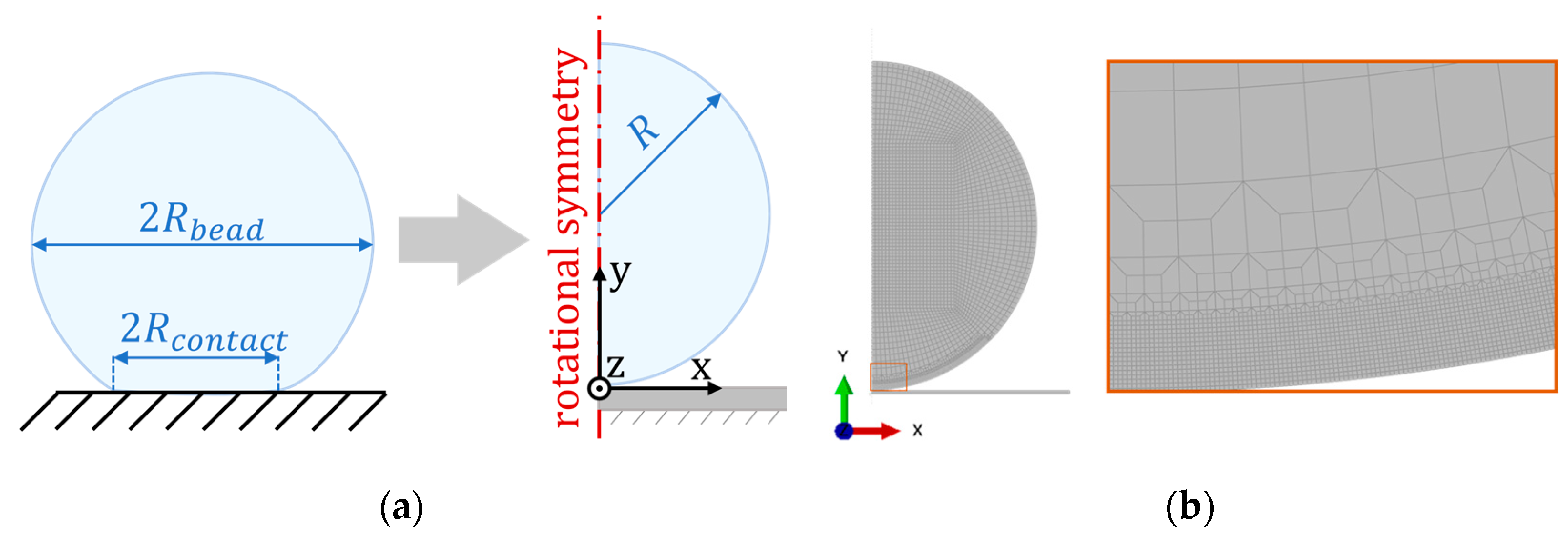

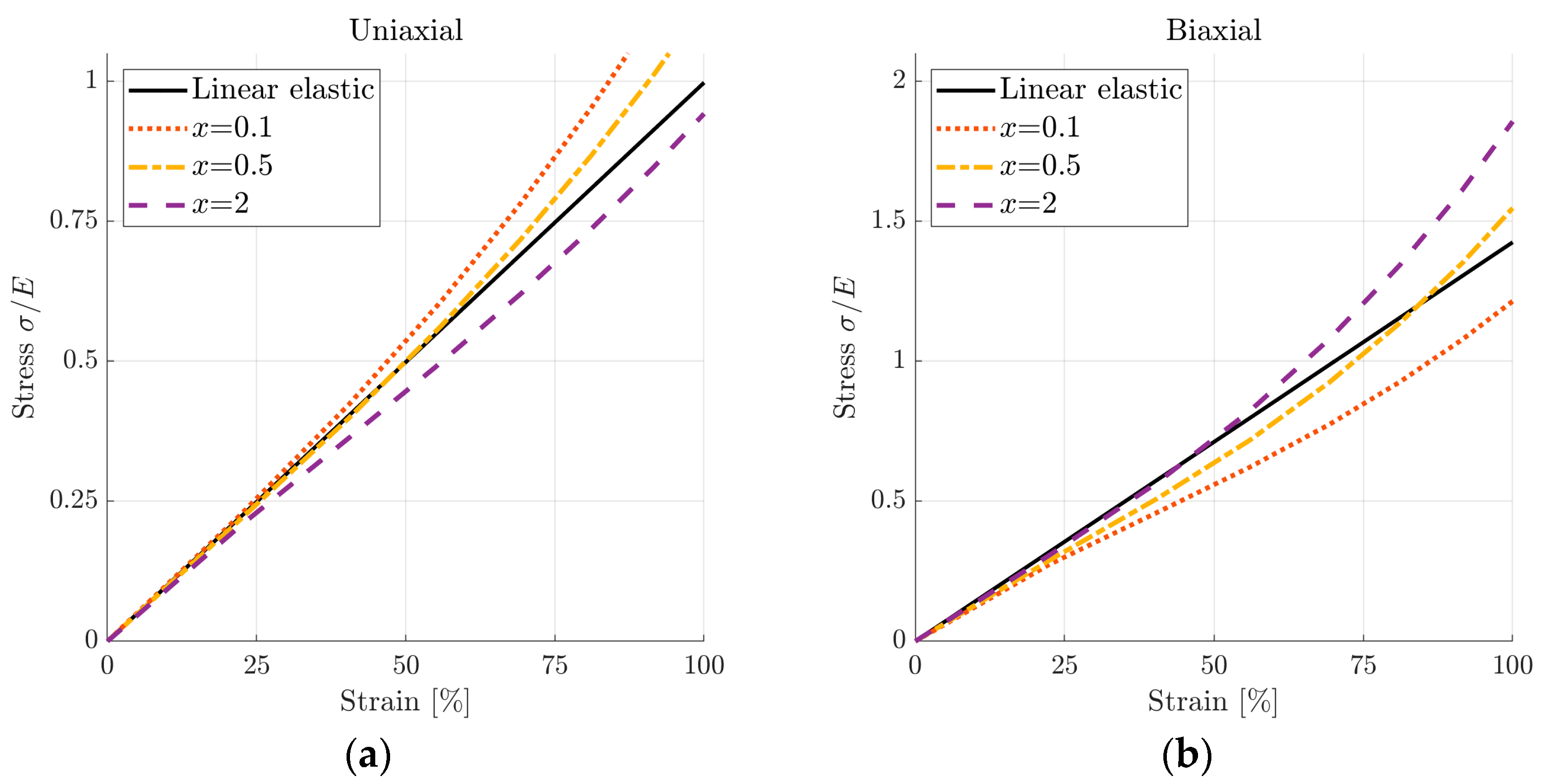

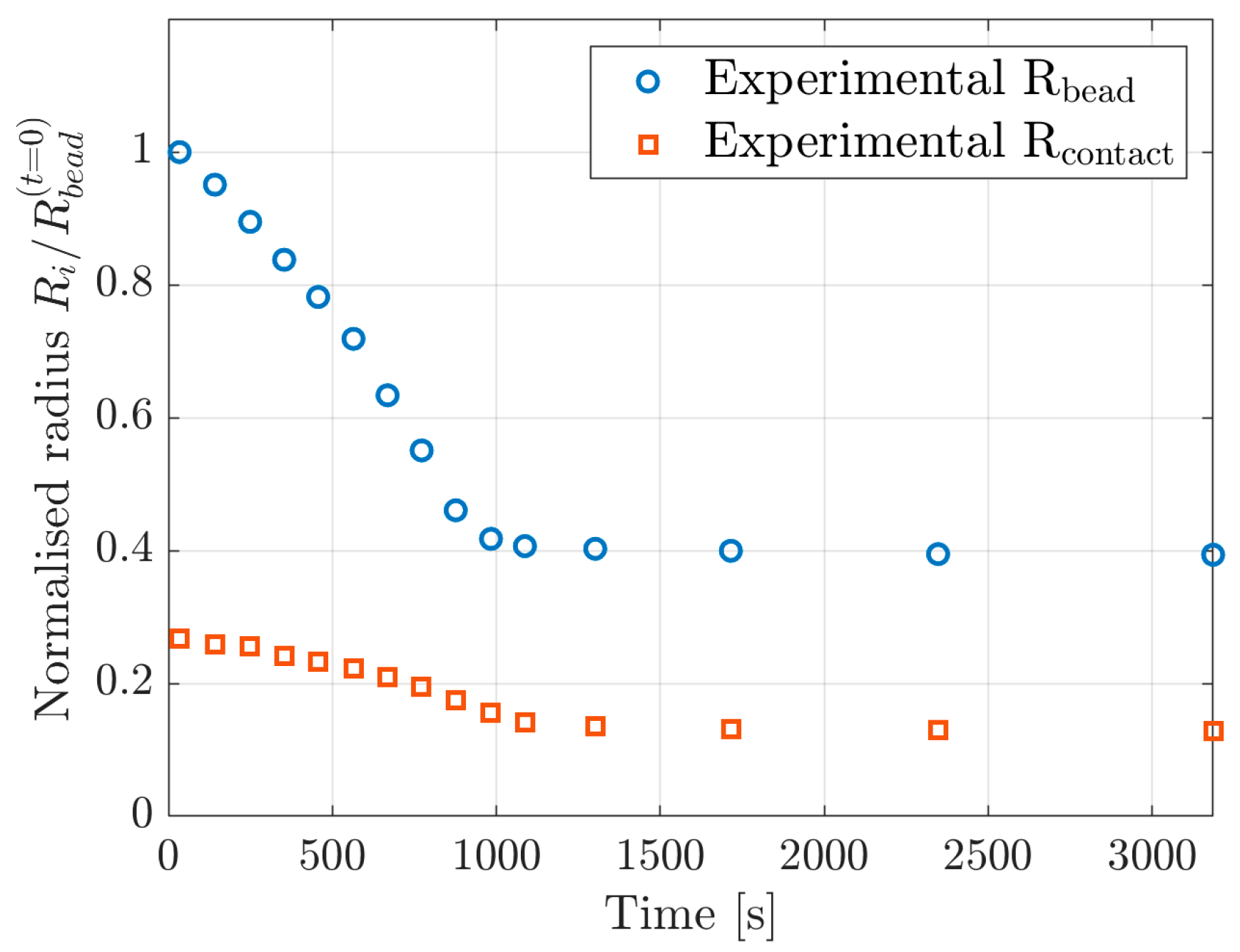
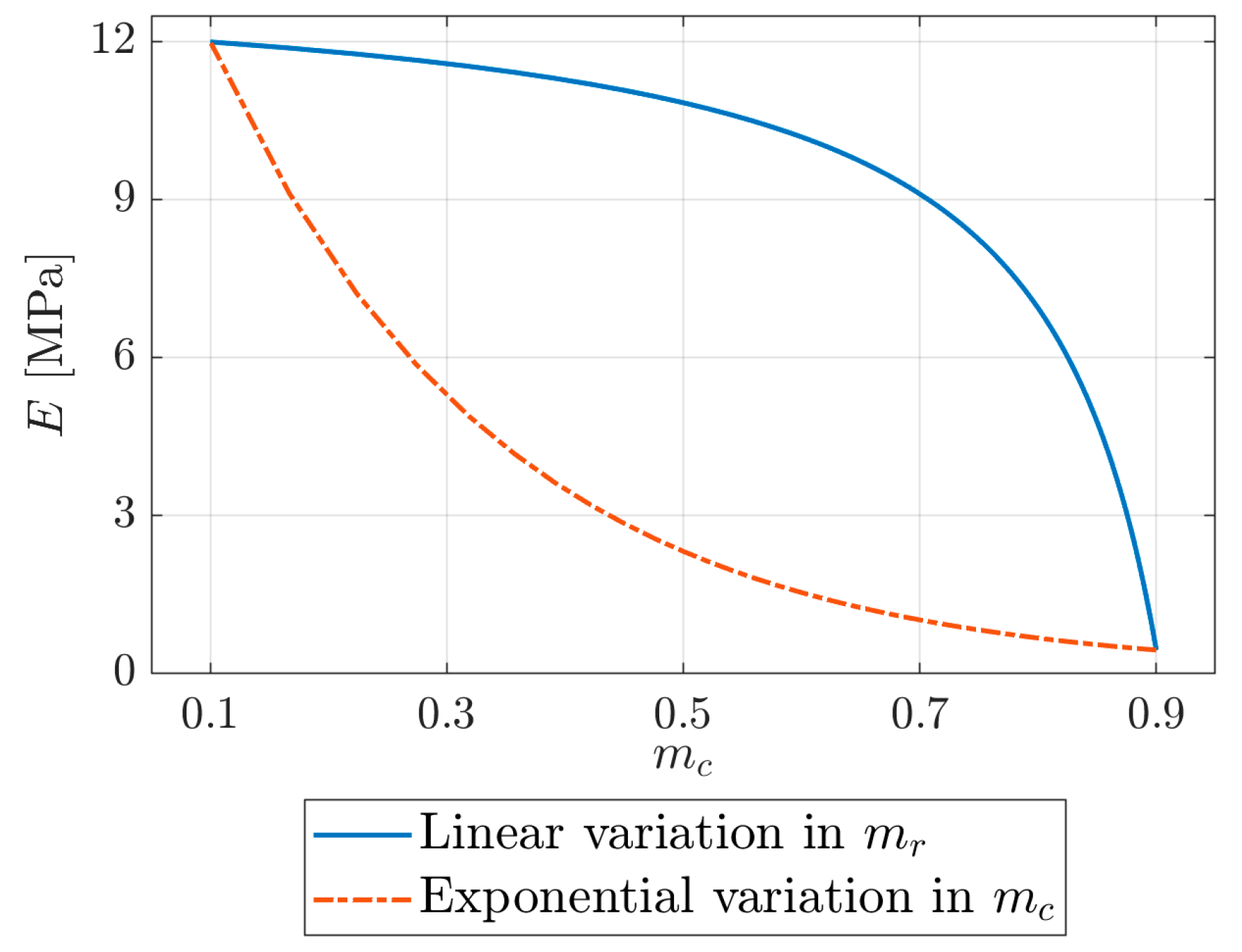
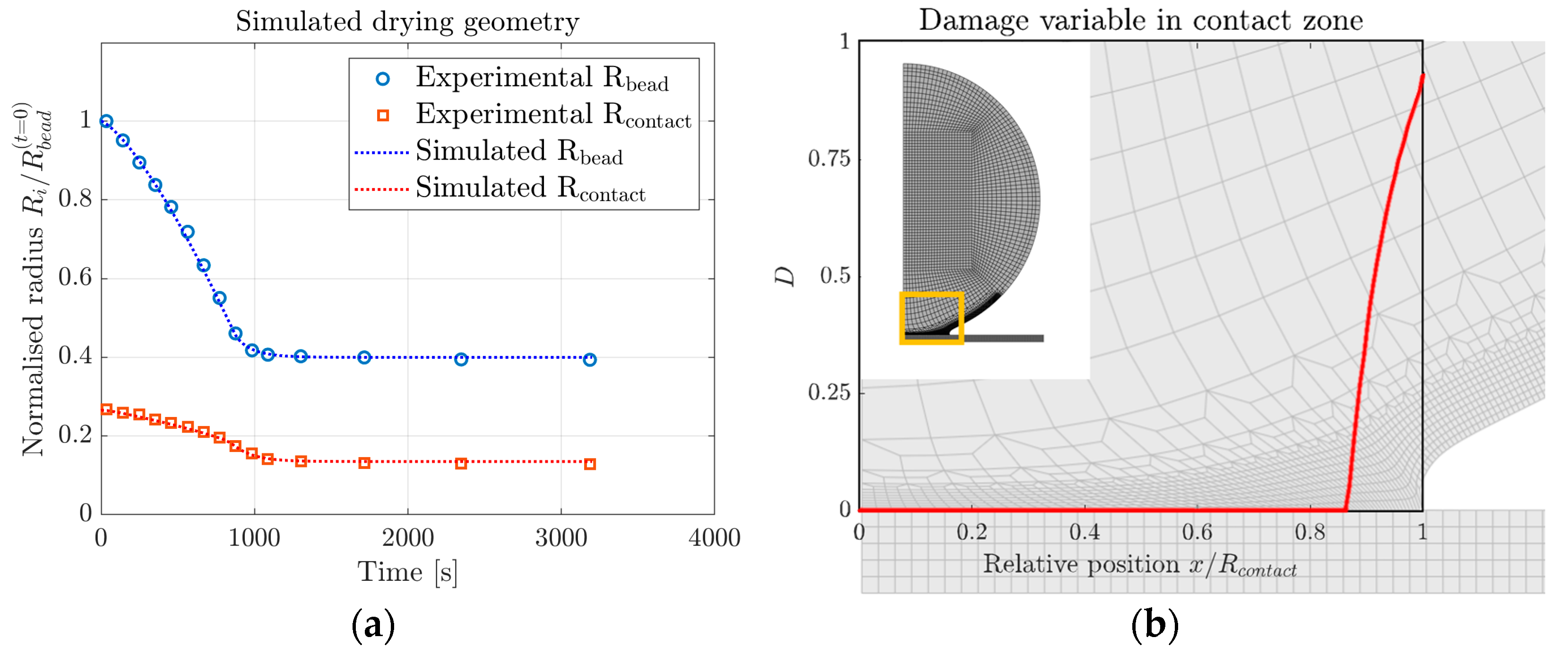

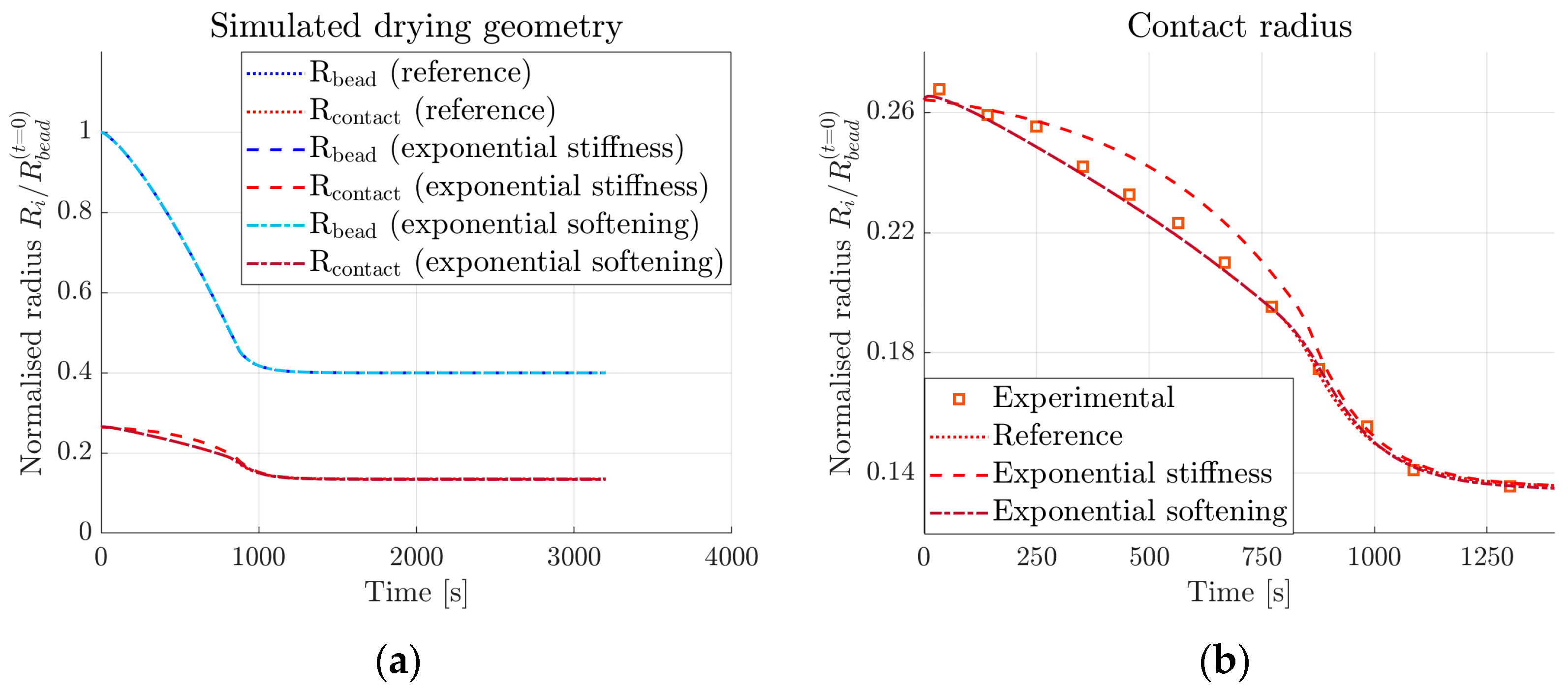
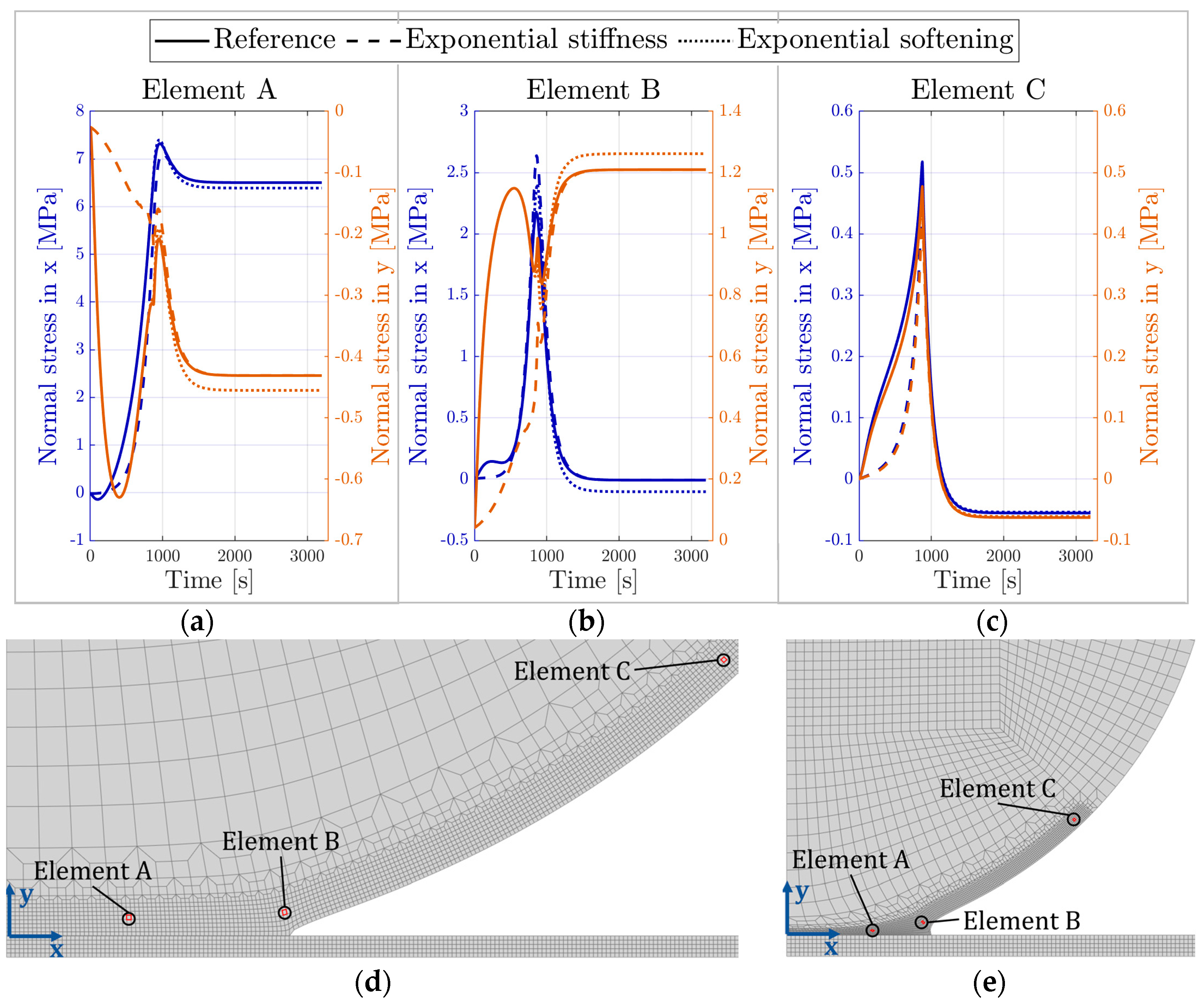
| Notation | Unit | Description |
|---|---|---|
| mm2/s | Diffusion coefficient (Equation (9) | |
| - | Expansion coefficient (Equation (10)) | |
| MPa/mm | Cohesive stiffness in the normal direction (Equation (11)) | |
| MPa/mm | Cohesive stiffness in the shear direction (Equation (11)) | |
| MPa | Maximum cohesive traction in the normal direction (Equation (12)) | |
| MPa | Maximum cohesive traction in the shear direction (Equation (12)) | |
| N/mm | Cohesive fracture energy (Equation (16)) |
| Notation | Unit | Value | |
|---|---|---|---|
| mm2/s | 5.0 × 10−4 | 5.0 × 10−5 | |
| - | 0.50 | 0.75 | |
| MPa/mm | 8.0 × 106 | 8.0 × 106 | |
| MPa/mm | 10 | 300 | |
| MPa | 1.0 × 103 | 1.0 × 103 | |
| MPa | 6.0 | 6.0 | |
| N/mm | 0.27 | 0.27 | |
Disclaimer/Publisher’s Note: The statements, opinions and data contained in all publications are solely those of the individual author(s) and contributor(s) and not of MDPI and/or the editor(s). MDPI and/or the editor(s) disclaim responsibility for any injury to people or property resulting from any ideas, methods, instructions or products referred to in the content. |
© 2023 by the authors. Licensee MDPI, Basel, Switzerland. This article is an open access article distributed under the terms and conditions of the Creative Commons Attribution (CC BY) license (https://creativecommons.org/licenses/by/4.0/).
Share and Cite
Kaplan, M.; Östlund, S. A Numerical Model for Understanding the Development of Adhesion during Drying of Cellulose Model Surfaces. Materials 2023, 16, 1327. https://doi.org/10.3390/ma16041327
Kaplan M, Östlund S. A Numerical Model for Understanding the Development of Adhesion during Drying of Cellulose Model Surfaces. Materials. 2023; 16(4):1327. https://doi.org/10.3390/ma16041327
Chicago/Turabian StyleKaplan, Magdalena, and Sören Östlund. 2023. "A Numerical Model for Understanding the Development of Adhesion during Drying of Cellulose Model Surfaces" Materials 16, no. 4: 1327. https://doi.org/10.3390/ma16041327
APA StyleKaplan, M., & Östlund, S. (2023). A Numerical Model for Understanding the Development of Adhesion during Drying of Cellulose Model Surfaces. Materials, 16(4), 1327. https://doi.org/10.3390/ma16041327







